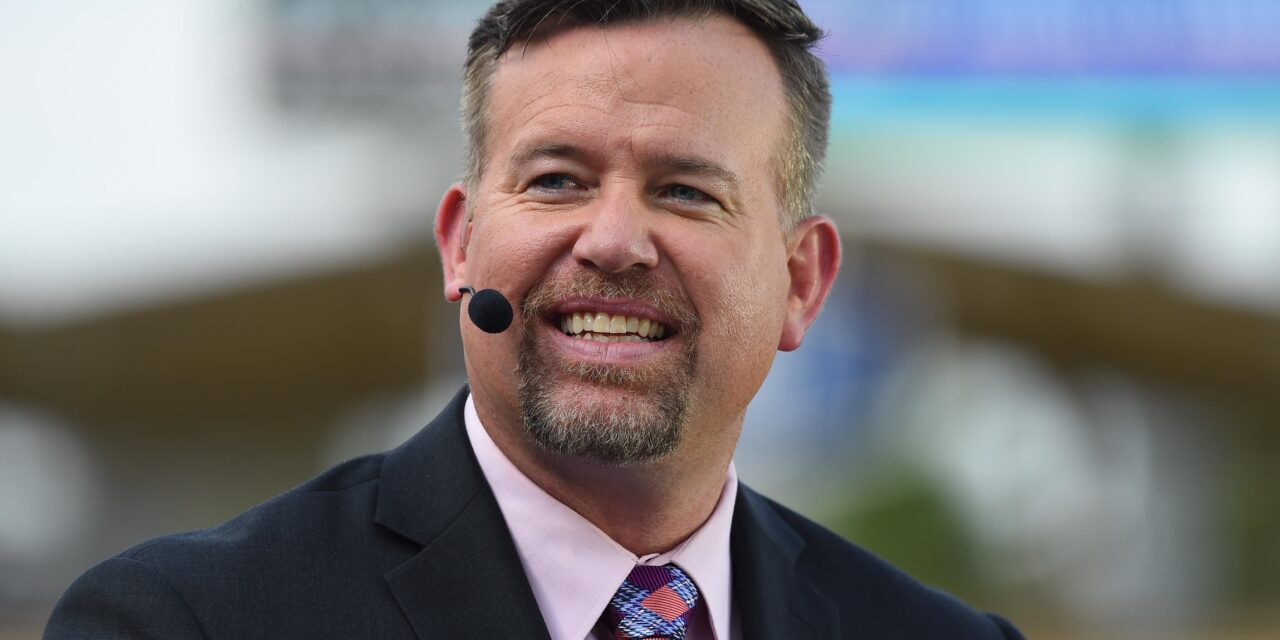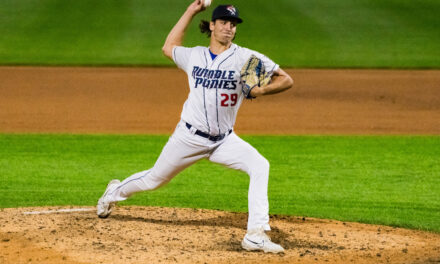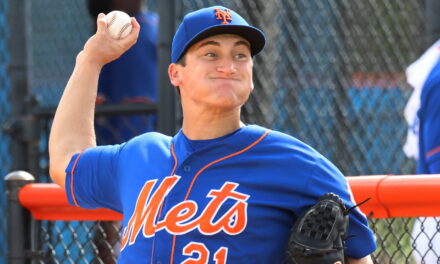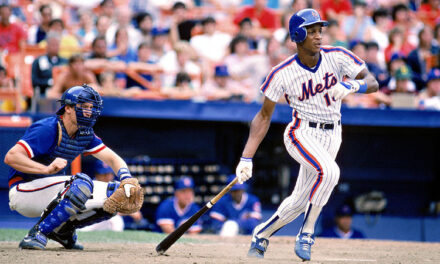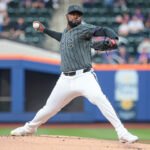
Throughout his professional baseball career, first baseman Sean Casey was always known for his big personality and benevolent charm.
If an opposing batter reached first base against one of the five teams Casey played for, a rousing conversation was likely to ensue.
Casey, 44, was a three-time All-Star who posted a career .302 batting average with 1,531 hits.
Originally drafted by the Cleveland Indians in the second round of the 1995 MLB Draft, Casey was dealt to the Cincinnati Reds for Dave Burba in 1998, one day prior to Opening Day.
His ’98 season got off to an inauspicious start, as he was struck in the right eye by a Damian Jackson throw during fielding practice. Casey needed 20 stitches to close the gashes around his eye and suffered a broken bone below the eye that required a plate and five screws to stabilize.
After a rehab assignment, Casey struggled in the majors and was optioned to Triple-A Indianapolis.
After posting a first-half OPS of .500 in 31 major league games, Casey rebounded in the second half of the season, posting a slash of .300/.394/.498.
Overall, Casey posted an overall line of .272/.365/.417 in 96 games in ’98 and posted the fifth-best wRC+ among National League rookies (106).
The ’99 season was Casey’s breakout year, as he made his first All-Star team and was second among qualified National League hitters in batting average in the first half of the season (.371). Casey would finish the ’99 season with a slash of .332/.399/.539, with 25 home runs and 99 RBIs in 151 games. His 197 hits were fourth-most among NL hitters while his .938 OPS was 14th-best.
After finishing fourth in the NL Central with 77 wins in ’98, the ’99 Reds added 19 wins to finish the season with 96 victories. With the Houston Astros winning 97 games and the NL Central, the Reds and Mets were set to play a one-game play-in to decide the NL wild card.
Casey and the Reds hosted the Mets at Cinergy Field in front of a packed and vocal Reds’ fan base. Unfortunately for Casey, he’d have to wait seven more years to play in the postseason as Al Leiter tossed a complete game, two-hit shutout in the Mets’ 5-0 win.
In 2006, Casey finally got to experience the postseason, as he was dealt to the Detroit Tigers (who won 95 regular-season games) from the Pittsburgh Pirates at the non-waiver trade deadline
After partially tearing his left calf muscle in Game One of the ALCS against the Oakland Athletics, Casey wouldn’t return to action until the first game of the Fall Classic.
In the five-game series, Casey slashed .529/.556/1.000, with nine hits, two homers, and five RBIs. He led both the Tigers and Cardinals hitters in hits, RBI, average, on-base percentage, and slugging.
Casey credits a drill that Tigers hitting coach Don Slaught instilled, in which first base coach Andy Van Slyke would throw Casey batting practice as hard as he could, helping Casey get locked in for game-like speeds.
Throughout his twelve-year career, which spanned from 1997 to 2008, Casey was regarded as one of the most affable players in the game, which included being voted the “Friendliest Player in Baseball” by his peers in a 2007 Sports Illustrated poll.
Affectionately known as “The Mayor” for his approachable and gregarious nature, Casey transitioned from the diamond to broadcasting following his final season in the majors with the Boston Red Sox in ’08. Casey blends his genial demeanor with analysis and personal anecdotes in his broadcasting style, making him a continued fan-favorite beyond his playing days.
Besides his duties with MLB Network, Casey remains busy as the president of the Miracle League of the South Hills, an organization that provides every child and adult the opportunity to play baseball. It serves the special needs community and affords them a safe place where they too can experience the great game of baseball. The Miracle League Field at Boyce Mayview Park features a rubberized surface to help prevent injuries and wheelchair-accessible dugouts.
I had the privilege of speaking with Casey in early January where we discussed the play-in game between Casey’s Reds and the Mets in ’99, working at MLB Network, and his wonderful foundation, the Miracle League of the South Hills.
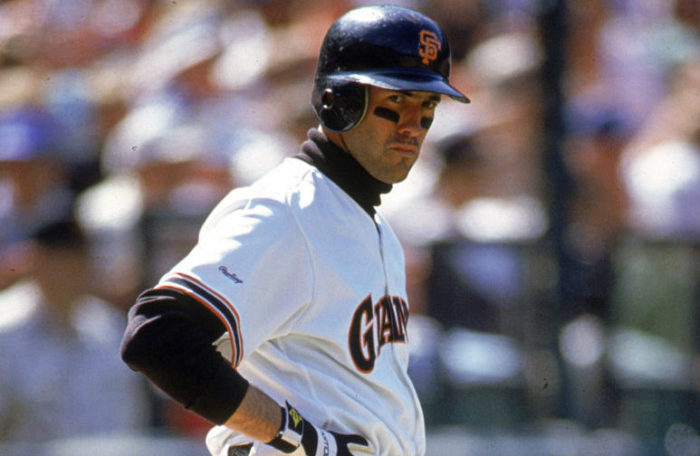
MMO: Who were some of your favorite players growing up?
Casey: My favorite player was Will Clark. I just loved the way he played the game and loved the way he hit as a left-handed hitting first baseman.
Mark Grace was another one of my favorite players and [Don] Mattingly; those are kind of like my three guys.
I also liked Andy Van Slyke a lot, too. I got a chance to have him be my coach when I was in Detroit. But a lot of those left-handed-hitting first basemen were guys I idolized.
MMO: At what point did you primarily start playing first base?
Casey: Travel all-stars and I was about 12-years-old. I was a little heavier, [I was] a bigger kid back then and they’re like, okay, you play first. [Laughs.] So I did and I just never left. It’s kind of funny looking back.
MMO: Prior to the 1995 Draft, did you have any idea that the Cleveland Indians were looking to take you in the second round?
Casey: I literally had no idea! I remember a Cubs’ scout telling me, “Hey if you’re there in the third round we’re going to take you.” I remember thinking, Oh cool, third round! That’s big time! I was saying to myself, This is going to be awesome!
I remember I got the call that day but it’s funny, the Draft had started, and back then it was obviously on the phone. I got a call that day and I answered it right away. It must’ve been like five minutes into the Draft, so I’m thinking there’s no way I’m the fourth pick in the draft!
It turned out to be my neighbor asking, “Hey, you want to go to McDonald’s and grab some lunch?”
I’m like, ‘Eric, it’s the Draft! Don’t call me. I have to get off the phone, I’m waiting for a call.’
Then about an hour later the Indians called me and said they selected me in the second round, so it was really, really cool. You look back on your life and your career and that was probably one of the coolest moments, and probably the greatest phone call I ever got.
MMO: Do you remember who first gave you the nickname “The Mayor”?
Casey: Oh yeah, there were two guys who really got it going. The guy’s an assistant head coach for T.C.U., his name is Bill Mosiello. He was my Cape Cod League coach when I was in the Cape in Brewster in 1994. It was two guys, Bill Mosiello and this other guy is Mike Kirby, he was a coach at Cal State Fullerton.
They were always busting my chops because I talked to everybody walking in like the broadcast and concession guys. I always talked to people at first, and to the fans coming out and all of that.
They were always like, “Man, it looks like you’re always lobbying for votes. Just talking to everybody all the time, you’re like the mayor. You’re lobbying for votes all the time!”
And it just kind of stuck. A guy named Jim Betzsold – who played for Cal State Fullerton – I played with him two years later in Double-A because we both got drafted by the Indians. And he goes, “Hey, what’s up, Mayor? I heard you’re the Mayor!”
I don’t know how it caught on but it just originated when I was in the Cape Cod League in 1994 and it just kind of caught on.
I remember I was watching Baseball Tonight one time, and Karl Ravech goes, “Sean Casey, ‘The Mayor’ hits one!”
I’m like, Oh my God, they said it on ESPN!
It went from the Cape Cod League to the Major Leagues, it’s unbelievable!
MMO: In a 2007 Sports Illustrated poll, you were voted as the “Friendliest Player in Baseball” by your peers. You were always acknowledged as one of the nicest players in the game, is that something you took pride in?
Casey: I do take pride in that. I just think growing up my dad was like, “Treat people the way you want to be treated. Be nice to everybody and never think you’re better than anybody else.”
That kind of stuck with me, you know?
It’s funny, looking back on my career, I kind of felt like a fan. I was just scared they were going to tell me that I wasn’t good enough anymore and just send me down. I was such a big card collector growing up, too, and I just loved baseball and autographs and stuff. I remember being in the big leagues and I just enjoyed talking to people at first base and enjoyed every part of the game because like I said, I just always felt like a fan.
I always felt very grateful and thankful for being in the big leagues.
MMO: I remember in a Dan Patrick radio interview you discussed your memorabilia collection. From what I remember, it’s a pretty massive collection, is that right?
Casey: Oh yeah, it’s unbelievable! One of the coolest bats I have is a Tony Gwynn one. I remember holding him on at first and he was getting his lead and I was like, ‘Hey, do you think you could send me over a bat?’
I think he kind of looked at me like dude, we’ve got a ballgame going on here. [Laughs.] It’s the coolest thing I have. You know the guy’s using the grips now? Well, the bat I have from Gwynn, there is like a tennis racket handle grip on it, it’s so cool. It’s a 32-inch bat, real small.
I have 180 bats that I collected over the years, and about 140 of them are probably from holding guys on and talking to guys at first. Just really, really cool.
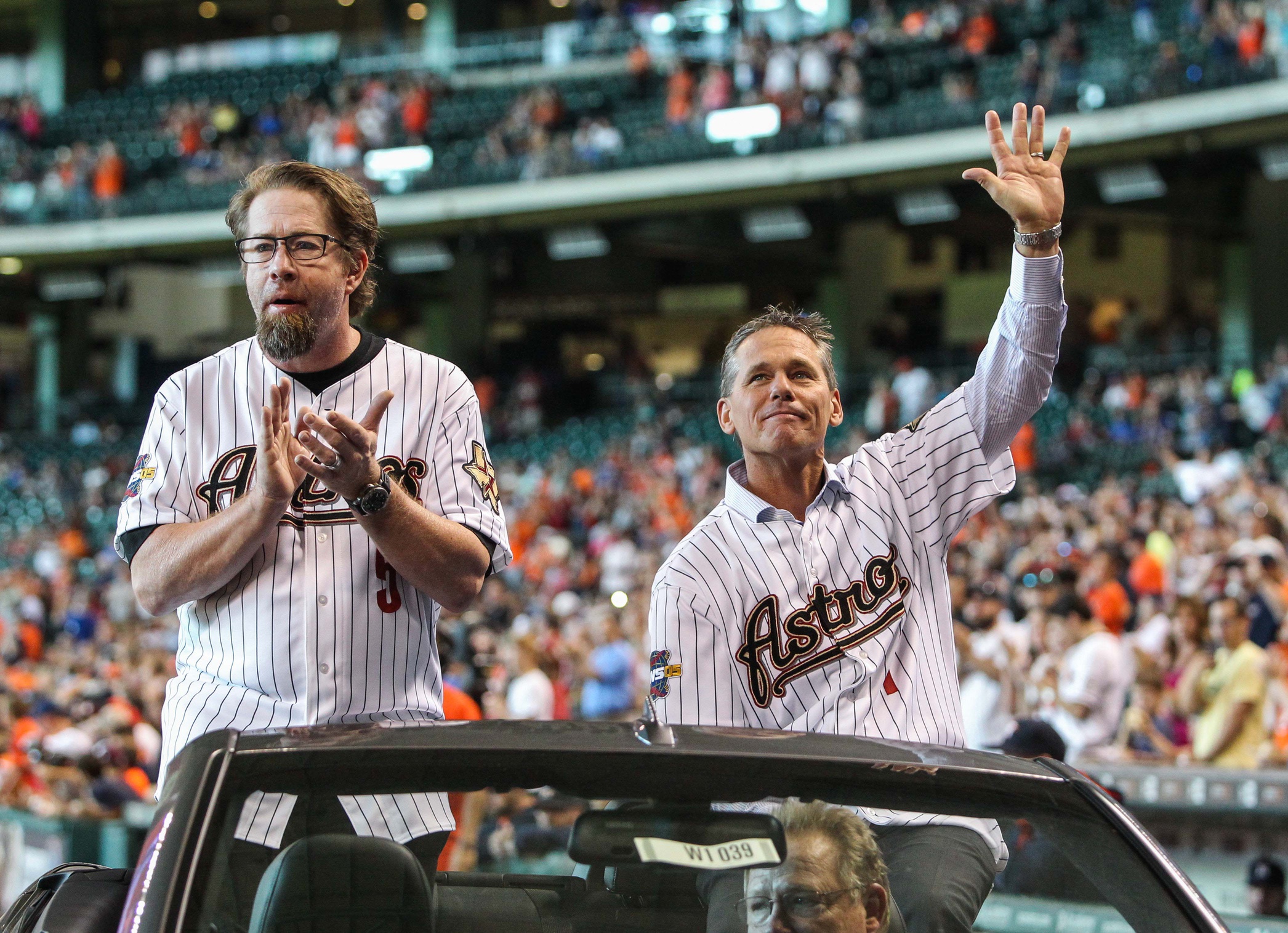
MMO: Speaking of holding runners on at first, considering you were such a personable guy, is there a player or two that stands out conversation-wise from your career?
Casey: Lance Berkman was my favorite, he and I were buddies. I don’t know if it was because we were first basemen and we’re not stealing and we know how to talk, but Lance will be over there and I’d beg for a long at-bat. Give me 3-2 so we can talk: ‘How are the kids doing? How’s the wife? What are you doing after the game? You want to come over? How’s everything going? How’s [Jeff] Bagwell doing? What about [Craig] Biggio?’
We just had all these conversations all the time and he was great to talk to.
Mark Grace was awesome. I mean, he was super funny, man. He was one of my idols growing up so I always enjoyed talking to him.
There are a lot of great conversations and I remember my rookie year when Mark McGwire and [Sammy] Sosa were doing their thing and I remember talking to McGwire at first base and just being really excited. I think they [Cardinals] came the day after he hit number sixty-two and played that night. I think we intentionally walked him or something, but there were just a ton of great conversations I’ve had at first base.
At some point, I wrote a bunch of conversations down because one day I was thinking about writing a book called Conversations in the Corner. And I can’t find them! I did it into a cassette tape and I can’t find it. [Laughs.] After every game, I would say something into it and I don’t know, I just lost it.
MMO: Your ’99 season was the first year you were selected as an All-Star & was a breakout year for you, as you posted the fourth-best batting average among N.L. hitters (.332). Were there any physical or mechanical adjustments you made prior to that season?
Casey: It’s funny, I look back on the mentality thing and I think I remember in the offseason hitting and really having the approach of driving the ball; I’m going to be aggressive to that fastball and I’m really going to hunt the fastball and I’ll be ready to go and drive it.
I think Opening Day I was 3-for-5, I hit a homer to put us ahead in the sixth against the Giants. It was just a cool day. Opening Day in Cincinnati is like a holiday, and I remember I just kept that going all year long. I think I was hitting like .371 at the break and I just was really focused on being able to see the ball and on being aggressive to it.
I remember keeping my approach really simple and not getting so caught up in my mechanics and everything but just getting my hands ready to go and get ready to just barrel up the baseball wherever it was.
MMO: Considering we are a Mets website, I’d be remiss not to ask you about Game 163 – which had you and the Reds facing the Mets for a one-game play-in to decide the N.L. wild card. What are your memories from that game?
Casey: [Laughs.] Oh jeez, I knew you would do it! I hate Al Leiter still. I work with the guy and I want to kill him. [Laughs.]
The first memory I have and I still replay is everything happens for a reason. But knowing we just needed to win two out three against Milwaukee to win the division, and just so many things had to happen to go wrong for us.
The Mets had to sweep the Pirates, the Astros had to sweep, and we had to lose two out of three for the one-game playoff. And then here we go, we lose the first two, the Mets end up sweeping the Pirates, and Brian Giles had just gotten hurt for the Pirates.
We’re in an eight-hour rain delay in Milwaukee watching all the NFL games and those games. Houston wins and they win the division and here we are at nine o clock at night having to play the Brewers just to get into that one-game play-in game the next day, when it was all in our hands. We win two of three in Milwaukee we’d win the division. So to have to play that game was crazy.
I remember getting home really late and I remember going to Jersey Mike’s Subs with my bags packed because as you know if we won we were going somewhere. I remember the fans at Jersey Mike’s saying, “Oh man, we’re so excited for the game tonight!”
There was such a buzz in the city because it was a home game and I just remember going out for batting practice that day and seeing 55,000 walk-up tickets in Cincinnati, just a packed house. It was the first time I ever felt that playoff atmosphere, like this is going to be unbelievable.
Then Edgardo Alfonzo comes up and hits that bomb and it kind of kills the crowd and then after facing Leiter in the first at-bat I was like, uh oh. He’s got that cutter working, we’re going to be in trouble. [Laughs.] We all knew we kind of had to buckle up and it just wasn’t our day. Leiter was typical Al, he was flat-out nasty and he did what he had to do.
And [Game] 163 is still a bummer because we won 96 games and we weren’t expected to do anything that year, we were supposed to be last. It was one of the coolest teams I had ever been on. Aaron Boone at third, Pokey Reese at second, Dmitri Young, myself, even the veterans like [Pete] Harnisch, Denny Neagle, and Greg Vaughn were just such great guys. Mike Cameron playing center field, Jeffrey Hammonds, Michael Tucker in right in the platoon. Brian Johnson backed up Eddie Taubensee behind the dish. Those guys, of my whole career, going back to that ’99 team was my favorite team ever, like not even close.
MMO: I spoke with Mike Cameron a few years ago and he also mentioned that ’99 team as one of the closest clubhouses he had ever been in.
Casey: Is that what he said? Me too! I felt that exact same way. Mike Cameron used to play DMX in the locker room, and I’ll still play DMX – and I don’t listen to rap at all – but I’ll still play DMX to bring me back to that year. It was unbelievable.
It was such a close-knit group and it made even more of a bummer because we knew how special that team was and like I said, to win 96 games back then and not get in was a tough one to swallow.

MMO: So working with Leiter at MLB Network, do you guys still talk about that game and give each other playful ribbing?
Casey: Oh, yeah! He still gets the best of me every once and a while. He’ll bring the clip out every once in a while.
What made it even worse was I think it was the ninth inning and we’re losing 5-0. Pokey Reese doubles to start the ninth, and I know Leiter’s dominating and we’re probably going to lose this game. I have 99 RBIs and Pokey’s on third [after a groundout by Barry Larkin] so I’m like, Alright, I just need to ground out here, put the ball in play, and get my 100th RBI.
Leiter ends up punching me out. [Laughs.] Not only do we lose the game, but my 100th RBI is sitting 90 feet away because freaking Leiter’s throwing me a sinker and I don’t think he even threw sinkers and he punched me out.
MMO: That’s right, you had two 99 RBI seasons.
Casey: That’s right. My second one in ’04 – and I thought my ’04 season might’ve been better than my ’99 season – but I went on the DL and I had 99 RBIs with eleven games to go. So I’m like, I’m going to get it.
Ryan Freel got hurt, who was like our leadoff guy, and I think in those last 11 games I had two RBI opportunities and I could remember trying to hit home runs and when that happens your swing goes to crap. It’s just the perfect storm of crap and in those 11 games I couldn’t get one RBI and it was so frustrating.
MMO: You finally got to play in the postseason with the Detroit Tigers in 2006. And in the World Series against the Cardinals, you were on a whole other level.
You led both the Cardinals and Tigers hitters in hits (9), RBI (5), average (.529), on-base percentage (.556), and slugging (1.000). What clicked for you during that Fall Classic?
Casey: You know what’s amazing? It’s a great question because Don Slaught was a great hitting coach at that time and it was funny because when I got traded to the Tigers the Pirates were my team growing up. And here I was I got [Jim] Leyland managing, Gene Lamont at third, Llyod McClendon is the bullpen coach, Don Slaught – Sluggo – is the hitting coach, Andy Van Slyke – who was one of my idols is the first base coach and Rafael Belliard. I’m like, these guys have no idea I just got traded to Bucco Heaven, they have no idea!
Don Slaught and Andy Van Slyke I really enjoyed them as hitting coaches; Van Slyke wasn’t the hitting coach but he knew hitting. Sluggo had this drill, he’d have Van Slyke – and he was jacked and still had a cannon of an arm – get in the cages down underneath, and he would throw it as hard as he could from batting practice distance. It must’ve been 100 mph. And the thought process was when you get in the box you’re going. Your thought process is yes, yes, yes, hunt the fastball. If it’s there, you’re swinging.
This drill was Andy throwing as hard as he could from BP distance and I was like yes, yes, yes. And if it was in the area… boom, I would go and I started getting so locked in. I hit early every day with Andy and Sluggo and that drill right there with two weeks to go got me so locked in it was unbelievable.
When I got to the playoffs and the World Series – even though I was out for 11 days – I ended up keeping my eyes fresh doing that drill with Andy when I was able to start hitting again. I give them a lot of credit for getting me locked in. When I was in the World Series and I felt like if you threw a BB up there I could hit it in the gap somewhere, it was crazy.
MMO: It’s interesting that you brought that anecdote up. Jason Ochart – who is the new minor league hitting coordinator for the Phillies and director of hitting at Driveline – thinks teams should utilize high-velocity pitching machines rather than traditional batting practice. What are your thoughts on that?
Casey: There are a few thoughts on that. I think batting practice is a lot about routine; it’s about getting loose. There’s something to be said about a ball that you can just throw me where I can really lock in and do what I want to do and get myself loose. I think that’s more of a cage work thing, where you can do it underneath. I don’t know if the batting practice guy could do it all year, in terms of throwing it that hard. There are so many games and not every guy has a cannon where they can throw it like that, you know?
MMO: During your twelve-year career, who would you say was the toughest pitcher you faced? And conversely, who did you fare best against?
Casey: The toughest pitcher I faced, it’s kind of funny when you look at it, but the guy I struggled most against was a guy named Steve Kline. Little lefty from the Cardinals and he used to frustrate me.
Every time we played the Cardinals, if it was 2-1 in the eighth Tony La Russa would bring in Kline. If it was 9-0 in the eighth, he’d bring in Kline and I’m like, alright, this guy’s messing with me now! It’s 9-0 and here comes Steve Kline with freaking two outs in the eighth just to face me knowing that I’m going to roll over or strike out! It was unbelievable, for some reason Kline was so nasty to me because he was a sinker/slider guy and we both came up in the minors together with the Indians so we were buddies too. He had my number.
I hit well against A.J. Burnett for some reason, I kind of had his number. I think I hit close to .500 off of him and when he was throwing close to 100 mph in Florida it was crazy! Jose Lima, Jon Lieber, and Andy Benes I hit well against. But Lima, yeah, I had his number for some reason, God rest his soul.
MMO: Can you talk about how you secured your job with MLB Network?
Casey: It was kind of a fluky thing. I was with the Red Sox in ’08. It was Game 5 and I was hitting batting practice and Harold Reynolds was doing the game for TBS because MLB Network didn’t exist yet. He’s doing the game for TBS and then he came down to the field. I was talking to him and I knew I was retiring, no one knew but me, and I’m like, ‘Hey man, how do you like broadcasting?’
And he goes, “I like it a lot, it’s awesome! It’s been a great gig for me after I was done playing.”
He asked why I was asking, and I told him I was going to retire soon. And he goes, “Really? You’re hitting .322!”
And I was like, ‘Yeah, but I’m ready. I’m ready to kind of just be home and move on.’
He told me, “Listen, I’m going to have Tony Petitti call you. This guy just started MLB Network and I just got hired there and it launches in January. You’d be great for it!”
Sure enough, Tony calls me and I go up and audition and I decided to do I think 50 days my first year just because I didn’t really want to do a lot of travel. Fifty days and it worked out great, man. I remember Al Leiter calling me because he was supposed to be one of the main guys and it was kind of funny talking to Al. But they hired me that year and this is my eleventh year and it’s just been crazy. That’s gone by so quickly too!
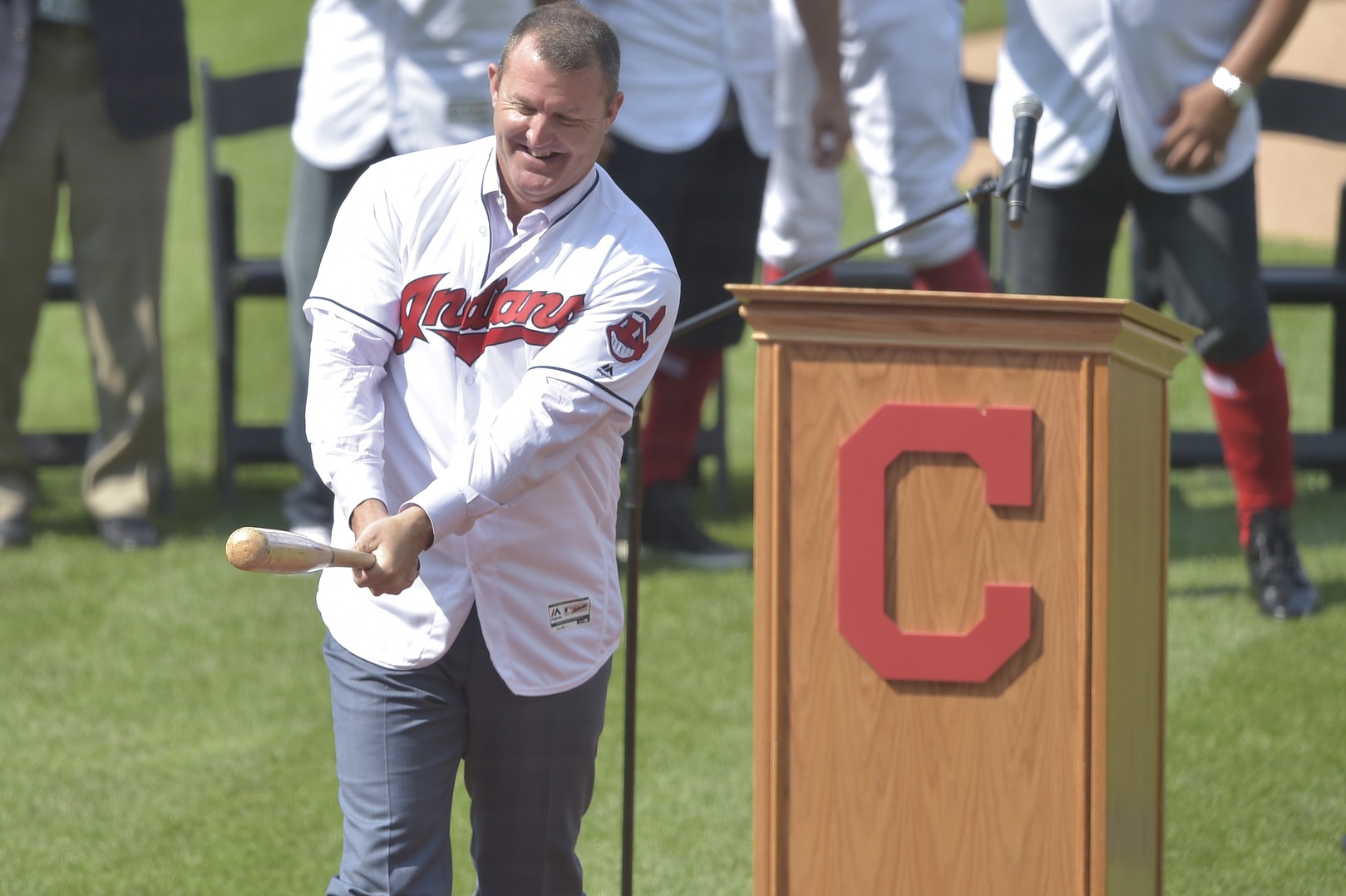
MMO: What’s the prep work like for you? Are there morning meetings where you discuss what you’d like to talk about on that night’s broadcast?
Casey: Yeah, about three or four hours before the show [we have meetings]. And the big thing is to think about breakdowns. Who’s hitting well? Why are they hitting well? What can we break down in the studio that would appeal to the masses and especially the kids out there and the coaches that could understand what these guys are doing? Why they’re doing it, what they do well.
The Diamond Demos that we do with hitting, that stuff is right in my wheelhouse and I love doing that. Billy Ripken does a great job of getting out there when we talk hitting and having Jim Thome there now to talk hitting with is pretty cool. They’ve done a great job of hiring and it’s almost like your new team when you’re with those guys out there and I just really enjoy it.
MMO: Talk to me about your organization, the Miracle League of the South Hills. How did that get started and what’s its core mission?
Casey: The Miracle League has really just been a blessing for myself, our community, and the kids that we have. A friend of mine started one up in Dayton in I think 2005. I threw out the first pitch and I remember thinking, man, this is really cool, what is this? It’s the Miracle League, it’s for special needs kids, it’s a rubberized surface.
My wife’s youngest sister has special needs and when I was in college after I got drafted and came back my senior year I worked at a school that had kids with cerebral palsy, so my eyes were open to the special needs community. We decided to build this Miracle League in the South Hills and give all kids a chance to play the game of baseball and it’s just a great combination. We’ve built a one-of-a-kind playground, too; an all-inclusive playground so we raised almost $2 million dollars to build this wonderful facility.
We’ve been going for a while and we have over 300 kids and Tim Gebhart has been an amazing director for us these last couple of years and has kind of taken us to another level. But we feel like we’re more than just a baseball league; we have a Halloween thing for the kids, a couple of dances during the year that we do. We have a program that we just started called Muscles for Miracles with a buddy of mine, John Dennis, who has a really nice facility and we have a lot of the higher functioning special needs kids come over there to lift weights and do all the things that all the other kids do.
We feel like we’re pretty much going twelve months a year just trying to make an impact in the community with the kids. The great thing about the Miracle League is all the kids need a buddy, so a lot of the buddies that help volunteer makes it really inclusive for everyone to be impacted.
MMO: And if readers want to donate or volunteer, how would they go about doing so?
Casey: You can go to miracleleaguesouthhills.org. You can go on there and if you’re in the Pittsburgh area you can come volunteer for us; we always need donations and we’re always looking for that. So anything anyone can ever give us is wonderful.
MMO: I can’t thank you enough for some time today, Sean. You were one of my favorite players growing up and it was a pleasure to speak with you today.
Casey: Mathew, I really appreciate that. It was great to talk with you.
Follow Sean Casey on Twitter, @TheMayorsOffice
Check out the Miracle League of the South Hills’ website here.
And check out the Miracle League of the South Hills’ largest fundraiser of the year here. The silent auction features amazing items such as autographed memorabilia, trip and experience packages, and a lunch for four with Sean Casey and Hall of Famer Jim Thome. The auction ends on February 22nd.


